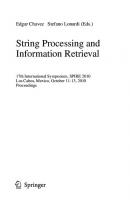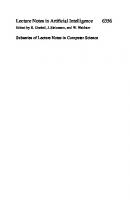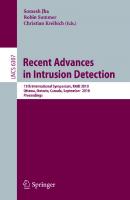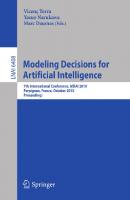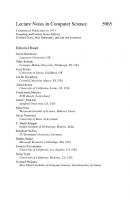Semantic Web Rules: International Symposium, RuleML 2010, Washington, DC, USA, October 21-23, 2010, Proceedings (Lecture Notes in Computer Science, 6403) 9783642162886, 3642162886
Constitutes the refereed proceedings of the International RuleML Symposium on Rule Interchange and Applications, RuleML
137 107 6MB
English Pages 318 Year 2010
Table of contents :
Title
Preface
Organization
Table of Contents
Keynotes and Invited Demos
Logical Spreadsheets
NIEM Canonical XML Dictionaries and Rule Engine Systems
Introduction
NIEM Canonical Dictionaries and OASIS CAM
Neutral Assembly Component Dictionaries
Mapping from Domains to NIEM Schema Components
Relating Schema Constructs to Neutral Syntax Components
Automatic W3C XML Schema Syntax Generation in NIEM Style
NIEM Naming and Design Rule (NDR) and Interoperability Factor Checking
Test Case Generation, Testing and Validation Framework
Conclusion
Related Work
References
Appendix A – Example NIEM Dictionary Entry XML
Appendix B – Example CAM Template XML
Appendix C – Comparing NIEM IEPD Timelines
Implementing SBVR with a Practitioner’s Perspective
Rules and Uncertainty
A Practical Management of FuzzyTruth-Degrees Using FLOPER
Introduction
Multi-adjoint Logic Programming
MALP Syntax
MALP Procedural Semantics
Truth-Degrees and Multi-adjoint Lattices in Practice
The FLOPER System in Action
Conclusions and Future Work
References
A Rule-Based Implementation of Fuzzy Tableau Reasoning
Introduction
Integrating RBSs with DLs
Rule-based vs. Description-Oriented Reasoning
Loose vs. Tight Integration
Existing Approaches
Embedding (Fuzzy) DL Reasoning in Production Rules
A Few Considerations on Integration Issues
Proposed Architecture
(Fuzzy) Tableau Algorithm
Tableau Queries : Comparing OWA and CWA
Examples
Conclusions and Future Developments
References
Rule-Based Event Processing and Reaction Rules
Ensuring Compliance with Semantic Constraints in Process Adaptation with Rule-Based Event Processing
Introduction
Preliminaries
Basic Notations in Business Process Management
Semantic Constraints
An Extended-ECA Model for Compliant Process Adaptation
Rule Specification
Change Operations
Compliance Checking with Semantic Constraints Using IP
Specification and Property of Semantic Constraints
Implicit, Redundant and Conflicting Constraints
Compliance Checking for Change Operations
Example
Analysis of the Example and Results
Discussion and Related Work
Conclusion
References
Establishing a Procedure Model for Combining and Synergistically Aligning Business Rules and Processes within Ontologies
Introduction
Background
S-BPM Approach
Business Rules Approach
Ontologies
Rule Enactment within S-BPM
Procedure Model for Representing and Linking Business Rules and Processes within Ontologies
Conclusions and Future Work
References
Rules and Inferencing
Rule-Based Contextual Reasoning in Ambient Intelligence
Introduction
Rule-based Contextual Reasoning: Challenges and Benefits
A Centralized Approach
Contextual Defeasible Reasoning, a Totally Distributed Approach
Main Features
Application to Ambient Intelligence
Discussion
References
Enhancing a Smart Space with Answer Set Programming
Introduction
Smart-M3
Use Cases
Answer Set Programming
Integrating ASP to Smart-M3
Implementation
Conclusions and Future Work
References
Superiority Based Revision of Defeasible Theories
Introduction
Norms and Preferences in Legal Reasoning
Defeasible Logics
Preference Defeasible Revision
Canonical Case: From +∂ p to −∂ p
Canonical Case: From +∂ p to +∂∼p
Canonical Case: From −∂ p to +∂ p
Conclusions and Further Work
References
On the Problem of Computing Ambiguity Propagationand Well-Founded Semantics in Defeasible Logic
Introduction
Basics of Defeasible Logic
Ambiguity Propagation
Computing Consequences in DL with Ambiguity Propagation
Well-Founded Semantics
Computing Consequences in DL with Well-Founded Semantic
Related Works
Conclusions
References
Rule Transformation and Extraction
Generating SQL Queries from SBVR Rules
Introduction
Generative Information Systems
Vocabularies to SQL Schemas
A Predicate Calculus for Advanced SQL DML Constructs
Basic Structure of an SQL Query
Arithmetic Operations and Aggregate Functions
Grouping and Having
From SBVR-LF to SQL DML
Conclusions and Future Work
References
Representing Financial Reports on the Semantic Web: A Faithful Translation from XBRL to OWL
Introduction
Representing XBRL Data Model for the Semantic Web: General Issues
Representing XBRL Concepts
Representing XBRL Relations
Representing XBRL Instances
Conclusions
References
Transformation of SBVR Compliant Business Rules to Executable FCL Rules
Introduction
Foundations on Model Transformation
Formalization of Business Rules and Business Contracts
Business Rules
Business Contract of Services
Contract of Services Editor Requirements
Transformation of SBVR Compliant Rules to FCL Rules
Model Transformation
Related Works
Conclusions and Future Work
References
Rules, Semantic Technology, and Cross-Industry Standards
RuleML 1.0: The Overarching Specification of Web Rules
Introduction
Design Rationale for RuleML
Deliberation Rules
Datalog RuleML
Hornlog RuleML
FOL RuleML
RuleML with Equality
Naf RuleML
Reaction Rules
Production RuleML
ECA RuleML
CEP RuleML
KR Reaction RuleML
RuleML Tools and Applications
Conclusion
References
XSLTs and XSDs for RuleML 1.0
Rules and Norms
Defining Access Control Rules with Conditions
Introduction
Running Example
Tool
Modeling the CRUD Access Matrix in SBVR
Business Entity Metamodel Vocabulary
"Quantification Collections"
Runtime Execution
Related Work
Summary and Future Work
References
Norm Compliance in Business Process Modeling
Introduction
Normative Constraints: Violations and Types of Obligation
Process Compliance Language (PCL)
Process Modeling
From Processes to Rules
Summary and Related Work
References
Application of an Ontology-Based and Rule-Based Model to Selected Economic Crimes: Fraudulent Disbursement and Money Laundering
Introduction
Used Technologies
Semantic Web Technologies
Types of Rules Used in Approach
Fraudulent Disbursement and Money Laundering Minimal Ontology Model
Rules that Define Logical Activities Appearing in the Penal Code Model
Conclusions and Future Work
References
Rule-Based Distributed/Multi-Agent Systems
A Contract Agreement Policy-Based Workflow Methodology for Agents Interacting in the Semantic Web
Introduction
Policy-based Workflow Methodology
E-Contracts
Intelligent Agents
E-Contract Agreement Workflow Automation Methodology
E-Contract Agreement Workflow Steps
Knowledge-Based Workflow Model
The EMERALD Knowledge-Based Framework
Implementing the Workflow Methodology on EMERALD
Use Case: The Wine Club
The Scenario Overview
Contract Terms and Information Specifications
Related Work
Conclusions and Future Work
References
Photorealistic Semantic Web Service Groundings: Unifying RESTful and XML-RPC Groundings Using Rules, with an Application to Flickr
Introduction
Grounding Web Services
Ground Rules
Working with XML and XML-RPC
Flickr
Related Work
Conclusion
References
Towards the Web of Models: A Rule-Driven RESTful Architecture for Distributed Systems
Introduction
Visions for the Future Web
Media Types
Model Propagation
Service Composition and Transactions
Conclusions and Future Work
References
Miscellaneous Rule Topics
Visualizing Logical Dependencies in SWRL Rule Bases
Introduction
Background
Related Work
Methods
Analyzing Dependencies among Rules
Generating a Rule Dependency Graph
Generating Rule Layers from the Dependency Graph
Clustering Rules with Similar Dependencies
Rule Base Visualization
Results
Discussion
References
An XML Format for Association Rule Models Based on the GUHA Method
Introduction
Related Research
GUHA Procedure ASSOC
GUHA AR Model
Boolean Attributes
GUHA Association Rule
Task Setting
AR Model Compatibility and Interoperability
Mining Schema
Output Fields
Transformation from PMML 4.0
Incomplete Support of GUHA AR PMML
Conclusion
References
Realizing Integrated Service Delivery through a Language for Collective Understanding of Business Rules
Introduction
Composed Expressions with Logical Operators
Composed Expressions with Temporal Operators
Composed Expressions with Geographical Operators
Conclusions
References
Authoring Business Rules Grounded in OWL Ontologies
Introduction
IBM WebSphere ILOG JRules
Authoring and Executing Business Rules from Ontologies
Authoring Business Rules from Ontologies: OWL to BOM Mapping
Executing Business Rules from Ontologies
Experiments and Results
Examples of Business Rules
Executing Rules
Related Work
Perspectives and Conclusion
References
Author Index
Title
Preface
Organization
Table of Contents
Keynotes and Invited Demos
Logical Spreadsheets
NIEM Canonical XML Dictionaries and Rule Engine Systems
Introduction
NIEM Canonical Dictionaries and OASIS CAM
Neutral Assembly Component Dictionaries
Mapping from Domains to NIEM Schema Components
Relating Schema Constructs to Neutral Syntax Components
Automatic W3C XML Schema Syntax Generation in NIEM Style
NIEM Naming and Design Rule (NDR) and Interoperability Factor Checking
Test Case Generation, Testing and Validation Framework
Conclusion
Related Work
References
Appendix A – Example NIEM Dictionary Entry XML
Appendix B – Example CAM Template XML
Appendix C – Comparing NIEM IEPD Timelines
Implementing SBVR with a Practitioner’s Perspective
Rules and Uncertainty
A Practical Management of FuzzyTruth-Degrees Using FLOPER
Introduction
Multi-adjoint Logic Programming
MALP Syntax
MALP Procedural Semantics
Truth-Degrees and Multi-adjoint Lattices in Practice
The FLOPER System in Action
Conclusions and Future Work
References
A Rule-Based Implementation of Fuzzy Tableau Reasoning
Introduction
Integrating RBSs with DLs
Rule-based vs. Description-Oriented Reasoning
Loose vs. Tight Integration
Existing Approaches
Embedding (Fuzzy) DL Reasoning in Production Rules
A Few Considerations on Integration Issues
Proposed Architecture
(Fuzzy) Tableau Algorithm
Tableau Queries : Comparing OWA and CWA
Examples
Conclusions and Future Developments
References
Rule-Based Event Processing and Reaction Rules
Ensuring Compliance with Semantic Constraints in Process Adaptation with Rule-Based Event Processing
Introduction
Preliminaries
Basic Notations in Business Process Management
Semantic Constraints
An Extended-ECA Model for Compliant Process Adaptation
Rule Specification
Change Operations
Compliance Checking with Semantic Constraints Using IP
Specification and Property of Semantic Constraints
Implicit, Redundant and Conflicting Constraints
Compliance Checking for Change Operations
Example
Analysis of the Example and Results
Discussion and Related Work
Conclusion
References
Establishing a Procedure Model for Combining and Synergistically Aligning Business Rules and Processes within Ontologies
Introduction
Background
S-BPM Approach
Business Rules Approach
Ontologies
Rule Enactment within S-BPM
Procedure Model for Representing and Linking Business Rules and Processes within Ontologies
Conclusions and Future Work
References
Rules and Inferencing
Rule-Based Contextual Reasoning in Ambient Intelligence
Introduction
Rule-based Contextual Reasoning: Challenges and Benefits
A Centralized Approach
Contextual Defeasible Reasoning, a Totally Distributed Approach
Main Features
Application to Ambient Intelligence
Discussion
References
Enhancing a Smart Space with Answer Set Programming
Introduction
Smart-M3
Use Cases
Answer Set Programming
Integrating ASP to Smart-M3
Implementation
Conclusions and Future Work
References
Superiority Based Revision of Defeasible Theories
Introduction
Norms and Preferences in Legal Reasoning
Defeasible Logics
Preference Defeasible Revision
Canonical Case: From +∂ p to −∂ p
Canonical Case: From +∂ p to +∂∼p
Canonical Case: From −∂ p to +∂ p
Conclusions and Further Work
References
On the Problem of Computing Ambiguity Propagationand Well-Founded Semantics in Defeasible Logic
Introduction
Basics of Defeasible Logic
Ambiguity Propagation
Computing Consequences in DL with Ambiguity Propagation
Well-Founded Semantics
Computing Consequences in DL with Well-Founded Semantic
Related Works
Conclusions
References
Rule Transformation and Extraction
Generating SQL Queries from SBVR Rules
Introduction
Generative Information Systems
Vocabularies to SQL Schemas
A Predicate Calculus for Advanced SQL DML Constructs
Basic Structure of an SQL Query
Arithmetic Operations and Aggregate Functions
Grouping and Having
From SBVR-LF to SQL DML
Conclusions and Future Work
References
Representing Financial Reports on the Semantic Web: A Faithful Translation from XBRL to OWL
Introduction
Representing XBRL Data Model for the Semantic Web: General Issues
Representing XBRL Concepts
Representing XBRL Relations
Representing XBRL Instances
Conclusions
References
Transformation of SBVR Compliant Business Rules to Executable FCL Rules
Introduction
Foundations on Model Transformation
Formalization of Business Rules and Business Contracts
Business Rules
Business Contract of Services
Contract of Services Editor Requirements
Transformation of SBVR Compliant Rules to FCL Rules
Model Transformation
Related Works
Conclusions and Future Work
References
Rules, Semantic Technology, and Cross-Industry Standards
RuleML 1.0: The Overarching Specification of Web Rules
Introduction
Design Rationale for RuleML
Deliberation Rules
Datalog RuleML
Hornlog RuleML
FOL RuleML
RuleML with Equality
Naf RuleML
Reaction Rules
Production RuleML
ECA RuleML
CEP RuleML
KR Reaction RuleML
RuleML Tools and Applications
Conclusion
References
XSLTs and XSDs for RuleML 1.0
Rules and Norms
Defining Access Control Rules with Conditions
Introduction
Running Example
Tool
Modeling the CRUD Access Matrix in SBVR
Business Entity Metamodel Vocabulary
"Quantification Collections"
Runtime Execution
Related Work
Summary and Future Work
References
Norm Compliance in Business Process Modeling
Introduction
Normative Constraints: Violations and Types of Obligation
Process Compliance Language (PCL)
Process Modeling
From Processes to Rules
Summary and Related Work
References
Application of an Ontology-Based and Rule-Based Model to Selected Economic Crimes: Fraudulent Disbursement and Money Laundering
Introduction
Used Technologies
Semantic Web Technologies
Types of Rules Used in Approach
Fraudulent Disbursement and Money Laundering Minimal Ontology Model
Rules that Define Logical Activities Appearing in the Penal Code Model
Conclusions and Future Work
References
Rule-Based Distributed/Multi-Agent Systems
A Contract Agreement Policy-Based Workflow Methodology for Agents Interacting in the Semantic Web
Introduction
Policy-based Workflow Methodology
E-Contracts
Intelligent Agents
E-Contract Agreement Workflow Automation Methodology
E-Contract Agreement Workflow Steps
Knowledge-Based Workflow Model
The EMERALD Knowledge-Based Framework
Implementing the Workflow Methodology on EMERALD
Use Case: The Wine Club
The Scenario Overview
Contract Terms and Information Specifications
Related Work
Conclusions and Future Work
References
Photorealistic Semantic Web Service Groundings: Unifying RESTful and XML-RPC Groundings Using Rules, with an Application to Flickr
Introduction
Grounding Web Services
Ground Rules
Working with XML and XML-RPC
Flickr
Related Work
Conclusion
References
Towards the Web of Models: A Rule-Driven RESTful Architecture for Distributed Systems
Introduction
Visions for the Future Web
Media Types
Model Propagation
Service Composition and Transactions
Conclusions and Future Work
References
Miscellaneous Rule Topics
Visualizing Logical Dependencies in SWRL Rule Bases
Introduction
Background
Related Work
Methods
Analyzing Dependencies among Rules
Generating a Rule Dependency Graph
Generating Rule Layers from the Dependency Graph
Clustering Rules with Similar Dependencies
Rule Base Visualization
Results
Discussion
References
An XML Format for Association Rule Models Based on the GUHA Method
Introduction
Related Research
GUHA Procedure ASSOC
GUHA AR Model
Boolean Attributes
GUHA Association Rule
Task Setting
AR Model Compatibility and Interoperability
Mining Schema
Output Fields
Transformation from PMML 4.0
Incomplete Support of GUHA AR PMML
Conclusion
References
Realizing Integrated Service Delivery through a Language for Collective Understanding of Business Rules
Introduction
Composed Expressions with Logical Operators
Composed Expressions with Temporal Operators
Composed Expressions with Geographical Operators
Conclusions
References
Authoring Business Rules Grounded in OWL Ontologies
Introduction
IBM WebSphere ILOG JRules
Authoring and Executing Business Rules from Ontologies
Authoring Business Rules from Ontologies: OWL to BOM Mapping
Executing Business Rules from Ontologies
Experiments and Results
Examples of Business Rules
Executing Rules
Related Work
Perspectives and Conclusion
References
Author Index
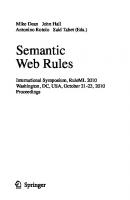
- Author / Uploaded
- Mike Dean (editor)
- John Hall (editor)
- Antonino Rotolo (editor)
- Said Tabet (editor)
